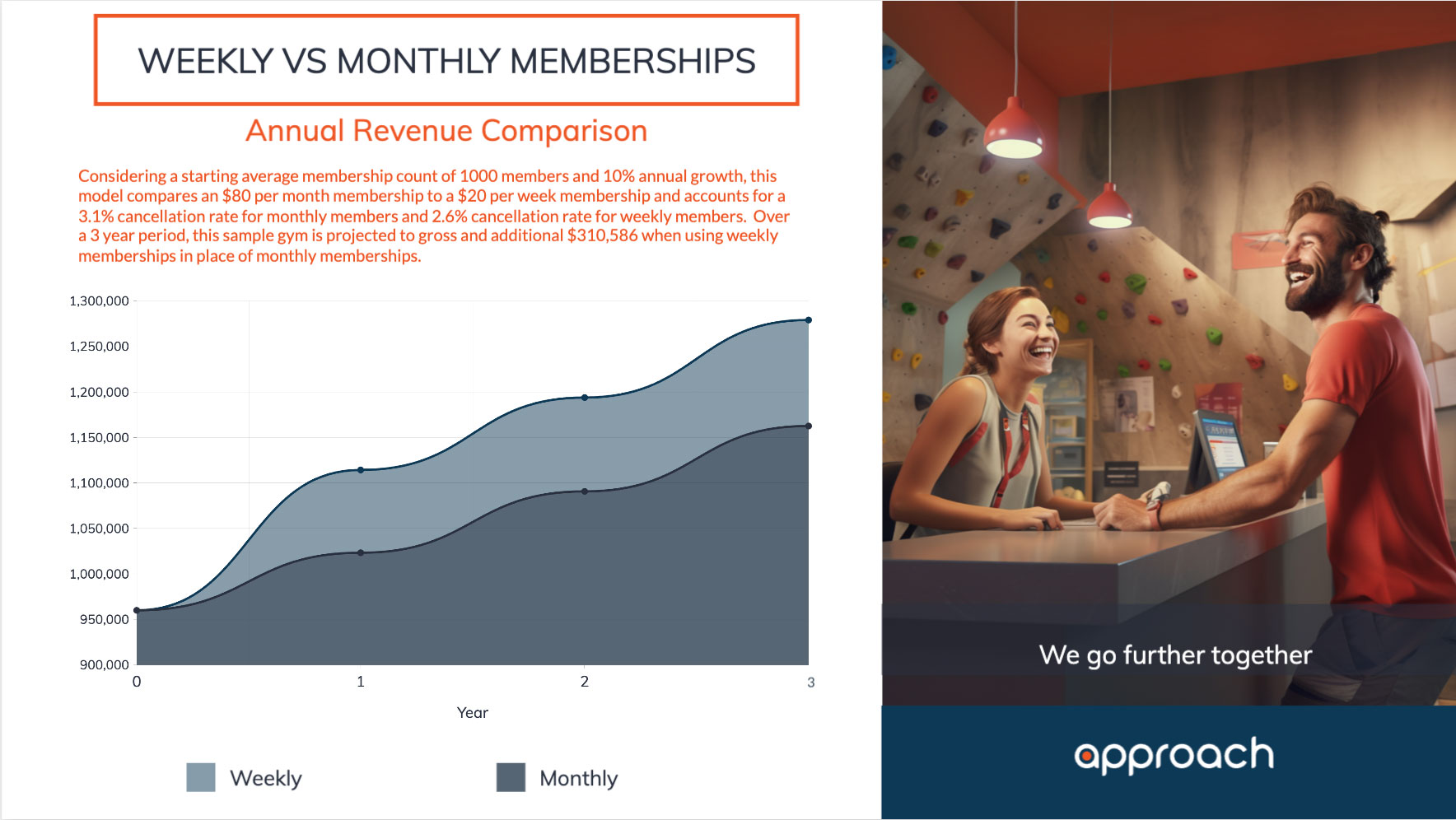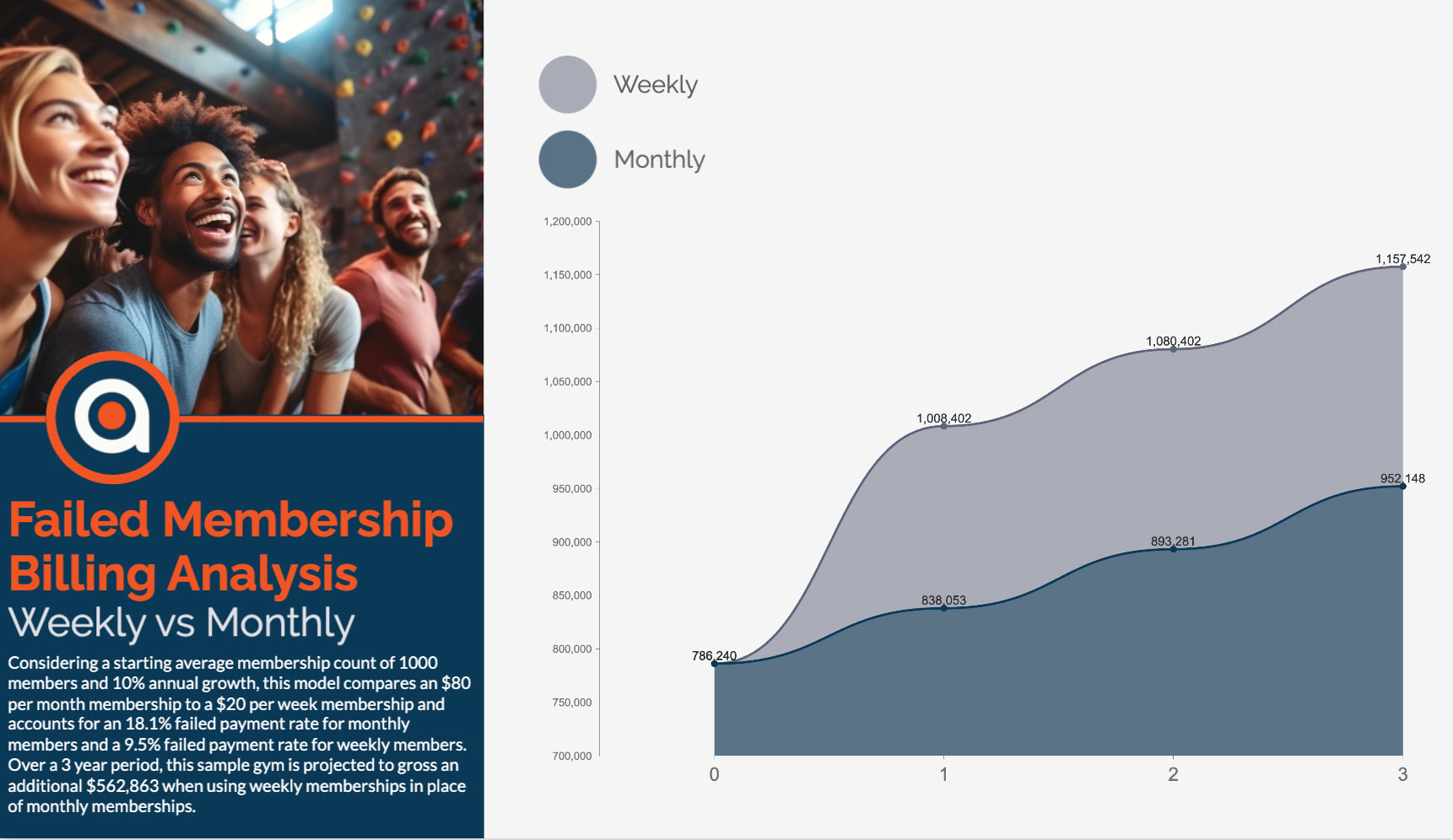Authored by Andrew Potter
Weekly memberships are not a foreign concept in the fitness industry, but they are definitely more uncommon, and in the climbing gym industry they’re almost non-existent. Approach did a case study across over 100,000 membership billing cycles at gyms using the Approach software to determine how weekly-billed memberships performed against the typical monthly membership. The results were unequivocal: billing weekly was better for businesses and customers. The goal of this article is to help shed some light on why offering members a weekly billing option could be an important addition to your offerings and help improve your business’s performance.
Supporting Your Operations
The climbing gym industry has seen a lot of major changes and improvements since the first climbing gym stateside opened in 1987, but the way members pay for access has stayed fairly steady. The biggest change has been pricing, which has naturally increased with improved product offerings and inflation, but the way members have been able to pay for access has almost always been monthly or prepaid yearly.
This constant begs an important question that many of you are likely wondering: “If the industry standard has always been monthly or annual memberships, why would I introduce a weekly-billed membership? The pros better be pretty amazing in order to consider this addition.” Well, the short answer is that they are, so let’s jump right in.
For starters, billing weekly will increase your revenue on that membership by 8% over a year, even if it’s the same weekly cost as the monthly-billed membership. This uptick is possible because when you bill monthly you are billing your members twelve times over the year, so you essentially bill them for 48 weeks, but when you bill them weekly you bill them for 52 weeks. That’s four more weeks of billing that are not captured when billing monthly.

While no one likes a price increase, a small bump is more likely to be well received when it’s going toward a good cause, like supporting the well-being of the staff running the gym. There’s a tertiary effect when you bill members in this manner, and we will use the recent month of June as an example. If you pay your employees every two weeks on a Friday, then in June you likely encountered paying payroll three times. For some companies, that could make finances a bit tighter. But if you bill weekly, you actually bill your members for a fifth week in June as well, helping to cover the operational costs associated with supporting that same membership.
Now let’s dig into some of the fun stuff…data.
Reducing Administrative Headaches
Membership logistics can be challenging to look at statistically because raw numbers change on a daily basis with new purchases, cancellations, members going on and off hold, etc. So, in order to simplify things, we looked at each time a membership was billed and then compared weekly billings to monthly billings. We focused on anonymized data from June 2022 to June 2023 from at least 15 gyms using Approach. Here’s what we found:
- Weekly-Billed: Across 94,641 billings, 9081 failed, which equals a 9.5% failure rate (a majority of these failures were due to insufficient funds).
- Monthly-Billed: Across 85,510 billings, 15,545 failed, which equals an 18.1% failure rate (a majority of these failures were due to insufficient funds).
Part of the reason that insufficient funds is the most common issue—as opposed to an expired or lost/stolen card—is because on Approach’s system if a consumer gets a new credit card, our processing solution “Approach Pay” automatically updates that card as soon as it is replaced. This automation limits the need to reach out to customers to capture new cards and helps to prevent involuntary churn. In addition, our auto-biller runs multiple times during the beginning of the month in order to recapture payments that were missed.
One reason that weekly-billed memberships fail on a smaller scale could be due to the payments themselves being so much smaller. It is more likely that an $80 membership payment will cause a credit card to bounce versus a $20 payment.

The next thing we looked at was cancellations. The question we wanted to answer was: “Do people cancel their memberships at a lower rate when billed weekly versus monthly?” The answer is yes, but the results were not as significant as we hypothesized. The reason could be due to the lack of a large data pool with weekly memberships, but that is a big assumption considering the results for failed payments were significant. Here’s what we found over a one-year period:
- Weekly canceled memberships equaled 2.6%.
- Monthly canceled memberships equaled 3.1%.
Although the weekly memberships outperformed the monthly memberships, the difference is fairly insignificant. It is our theory, based on our analysis of the data and talking to gym owners, that a majority of the lost dollars unfortunately come from a failed membership billing in which the customer does not return and bets on the fact that their local gym will not take them to collections. If that hypothesis is the case, preventing failed payments could be key in slowing member churn and, according to our findings, billing weekly can help accomplish that goal.
Giving Members Options
Based on our research and our discussions with gyms across the industry, we believe that billing weekly is a great tool that any gym can add to their arsenal. There are also some other positive aspects of weekly billing that are hard to quantify through data but we believe are worth mentioning, so let’s talk about those benefits next.

One of those positives is that consumers are less likely to cancel a $20 weekly payment versus a monthly payment when, in many cases, the weekly payment is very close to the cost of a day pass. The same goes for membership purchases. A few of the gym owners we have spoken with have an easier time converting members from a day pass purchase to a $20 weekly membership versus an $80 monthly membership, even though they pay the same price every 4 weeks. Lowering barriers to entry makes financial sense for your business, and it’s good for customers and the sport of climbing as well.
Weathering the Unexpected
The next big positive about weekly memberships is that they can actually help your business ride the waves of economic or other shocks. The extreme scenario dates back to the start of the pandemic, when climbers paid for an entire month of membership only to see their gym shut down, raising questions about getting their money back. In the scenario of a weekly-billed membership, you capture a significantly less amount of money upfront than a product that takes 30 days to use.
It is our observation that most gyms in the industry use cash-based accounting, with a handful of the larger operators using GAAP reporting. Well, if you realize revenue based upon how much a membership has been used, like in GAAP reporting, then weekly-billed memberships get realized much faster and decrease your outstanding liabilities. Here’s an example: A gym has 1000 members paying $80 a month and they are billed monthly. Halfway through the month, the business has a flood and must shut down. That business has $40,000-worth of outstanding liability that members could ask for since they cannot use the facility, as opposed to $10,000-worth of outstanding liability if all those members had been on weekly billing.

The last consideration for offering weekly memberships is dealing with chargebacks. Just about every gym that we have spoken with has had a member who pays for a membership for six months and then calls the gym saying, “I didn’t know that I was paying for it, and I want my money back.” We’ve unfortunately heard stories about some members even using a gym for two to three months and still submitting three chargebacks for their membership. When you bill weekly, there is a greater amount of effort required by the consumer to submit twelve separate chargebacks for three months. Fortunately, most customers aren’t out to game the system, and weekly billing can help gyms and customers avoid getting into this situation at all. Even if there aren’t multiple chargebacks, we believe it’s less likely for someone to submit a single chargeback over a $20 payment versus an $80 payment.
Staying Ahead of the Curve
Overall, we believe that in less than five years a significant portion of the climbing industry will be leveraging weekly memberships to strengthen their business and give their customers more options. It’s not a new concept, but in this industry it is not currently widely adopted. Today, we have more and more clients making the decision to sell weekly memberships, and we are excited to see their business performance increase with the offering.
Approach’s goal as a company is to build world-class products that help small business owners across the world make their business better for everyone involved. We continue to build features that are changing the game for gym owners, and we’re not stopping anytime soon.
About the Author

Andrew Potter is an American entrepreneur and founder or co-founder of multiple companies (including ROKC climbing gyms and Approach), and community is the heart of his mission.
Conceptualized in 2014 during his third tour in Afghanistan with the 75th Ranger Regiment, ROKC began as a dream to make climbing available to everyone in Kansas City.
After dealing with the struggles of operating a multi-facility climbing gym company, Andrew co-founded Approach with the hopes that he could ease the pain that he went through for other gym owners. His goal of providing enterprise-level products for small business owners is still his focus today.
Aside from business, Andrew is still an avid climber and loves surfing on jugs in the Red River Gorge.
Most importantly, Andrew is a loving husband and father to three children.
This story was paid for by the sponsor and does not necessarily represent the views of the Climbing Business Journal editorial team.

Approach is a fully integrated, customizable gym management platform that helps you manage all elements of your climbing and fitness offerings. From membership management and comprehensive calendaring to your point-of-sale system, our unified platform streamlines your operations and helps you grow your business. From the onset, we have focused on capturing data that would scale and give business owners visibility critical to growth. We are dedicated to constantly adding features and maintaining a product that is evolving with the industry. Request a demo today.







